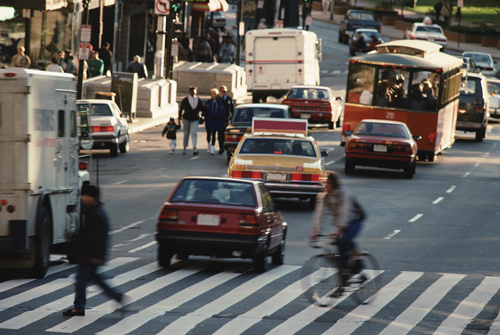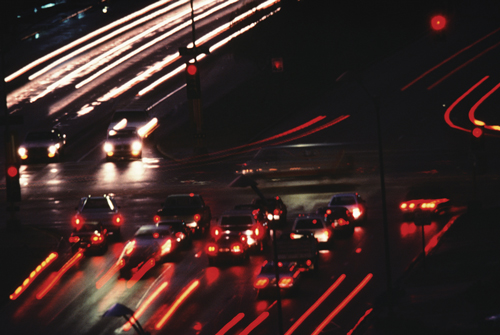
URBAN CRASHES Q&A'S:

Insurance Institute for Highway Safety
The following data was accumulated and examined by the Insurance Institute for Highway Safety in 2010 and is the most current report available on urban crashes.
Q&As, which address frequently asked questions about highway safety, are updated continuously by the Insurance Institute for Highway Safety as relevant information is acquired.
1. How significant is the problem of urban crashes?
More crash deaths occur in rural areas. In 2009, 63 percent of crash deaths occurred in rural areas. However, vehicle miles traveled are increasing rapidly in urban areas where most of the U.S. population lives. From 1985 to 2009 total vehicle miles traveled rose 68 percent, but miles traveled in urban areas grew 91 percent.
Pedestrian deaths and injuries are more prevalent in urban areas. Seventy-one percent of pedestrian deaths in 2009 occurred in urban settings.
Crashes that cause nonfatal injuries and/or property damage also are more frequent in urban areas. A 2008 Insurance Research Council study of a national sample of automobile crash injury claims found that 80 percent of the crashes occurred in urban areas. The Highway Loss Data Institute examined insurance losses by vehicle density for 2003-05 model year vehicles. The collision claim frequency rates (claims for vehicle and other property damage per insured vehicle years) and the injury claim frequency rates were higher in the densest areas compared to the least dense ones.
2. What are the most common types of urban crashes?
A 1995 Institute study of more than 4,500 crashes in 4 urban areas found that 22 percent involved drivers who ran red lights or other traffic controls such as stop or yield signs. Eighteen percent occurred when a vehicle that was stopped or in the process of stopping was struck from the rear. The 3 other leading types of urban crashes included running off the road and striking an object (14 percent), swerving into another occupied lane (13 percent), and turning left and colliding with an oncoming vehicle (9 percent). These 5 crash types accounted for three-fourths of all urban crashes included in the Institute's study and 83 percent of crashes involving injuries.
3. Which crashes are most likely to cause injuries?
According to the 1995 Institute study of urban crashes, 41 percent of urban crashes associated with a vehicle turning left into oncoming traffic involved injuries. These crashes often involved a side impact. More than a third of the crashes typed as running a red light or other traffic control, rear ending a stopped or stopping vehicle, and running off the road involved injury. In contrast, injuries occurred in only 16 percent of crashes involving lane change maneuvers.
4. Where and when do urban crashes occur?
Nearly half of all urban crashes occur at intersections. Based on a nationally representative sample of crashes, an estimated 1.2 million urban crashes occurred at intersections or were deemed intersection related in 2009. Of these crashes 55 percent occurred at traffic signals. An additional 21 percent occurred at stop signs. A higher proportion of injury crashes occurred at intersections (52 percent) compared with property damage only crashes (42 percent).
Pedestrians in urban areas are more likely to be injured in crashes at intersections than at other locations. In 2009, 61 percent of urban crashes involving injured pedestrians occurred at intersections. A 1993 study of fatal pedestrian crashes in 4 U.S. cities found that 40 percent of the crashes involving vehicles other than large trucks and 51 percent of the crashes involving large trucks occurred at intersections.
Most urban crashes happen during the afternoon or early evening. In 2009, 59 percent of urban crashes occurred between noon and 9 p.m. An additional 26 percent were between 6 a.m. and noon. While only a small percentage (7 percent) of urban crashes occurred between midnight and 6 a.m., 24 percent of fatal urban crashes happened during these hours.
5. What traffic engineering countermeasures can officials implement?
Institute research has found that crashes on urban roads often are concentrated at specific locations and occur in patterns that can be reduced through relatively simple and inexpensive engineering modifications. An evaluation of low cost engineering counter measures implemented at six locations with significant clusters of specific types of crashes found large reductions in the targeted crash types. At two intersections where protected left turn signals were installed (to permit left turns only when opposing traffic is stopped), left turn crashes were eliminated compared with left turn crashes that occurred frequently prior to the signal changes.
The most common crash type — a driver running a traffic control — might be reduced by lengthening signal clearance intervals, improving signal and sign visibility, increasing sight distances, and reducing vehicle speeds near intersections.
A 2002 Institute study of modified yellow and all red traffic signal timing at urban intersections reported that injury crashes were reduced by 12 percent at experimental sites relative to control sites. A 2002 Federal Highway Administration study reported that adding left turn and right turn lanes can reduce intersection crashes.
The addition of left turn lanes at urban unsignalized intersections reduced crashes by about 30 percent. Intersection crashes also can be substantially reduced by installing modern roundabouts in place of signals and stop signs. A 2001 Institute study of 23 intersections reported that converting from traffic signals or stop signs to roundabouts reduced injury crashes by 80 percent and all crashes by 40 percent. At signalized intersections with low traffic volumes crashes can be reduced by installing multiway stop sign control. A 1997 Institute study reported that multiway stop sign control in place of traffic signals reduced crashes by 24 percent.

6. Can technology such as speed and red light cameras help reduce urban crashes?
Common traffic infractions such as speeding and red light running are associated with many urban crashes. Speed cameras and red light cameras can help police enforce traffic laws in dense urban areas where traffic pursuits and stops can be dangerous to officers and to other motorists and pedestrians.
Institute research indicates that red light camera enforcement generally reduces violations by 40-50 percent and injury crashes by 25-30 percent.
Speed cameras, used to enforce speed limits, have been used on a limited basis in the United States but are used extensively throughout Europe and in Australia. The Institute examined the effect of speed cameras in the District of Columbia, Scottsdale, Ariz.., and Montgomery County, Md., and found that the proportion of drivers traveling more than 10 mph faster than posted speed limits declined 70 percent to 88 percent.
The effects of speed cameras on crashes have been the subject of considerable research as summarized in two recent systematic reviews. Pilkington and Kinra (2005) reviewed 14 studies that found crash reductions in the immediate vicinities of camera sites ranging from 5 to 69 percent for all crashes, 12 to 65 percent for injury crashes, and 17 to 71 percent for fatal crashes. Wilson et al. (2006) reviewed 21 studies that found reductions ranging from 14 to 72 percent for all crashes, 8 to 46 percent for injury crashes, and 40 to 45 percent for crashes involving fatalities and serious injuries.
7. Can vehicle design changes help reduce urban crashes?
Yes. Many vehicle features can reduce urban crashes or their consequences. Head restraints can prevent whiplash injuries in relatively minor rear end crashes, the kind that occur frequently on urban streets. Rear end collisions account for about 18 percent of all urban crashes, second only to crashes involving running a traffic control. Neck injuries, particularly whiplash, occur with significantly higher frequency in rear end crashes than in other crash configurations.
A 1999 Institute study found that 26 percent of rear struck vehicle drivers reported neck injuries. The Institute publishes head restraint ratings for a range of passenger vehicles based on geometry and dynamic testing. A 2008 Institute study examined insurance claims for evidence of driver neck injury for cars and SUVs struck in the rear by the front of another passenger vehicle. Driver neck injury rates were 15 percent lower for vehicles with seats rated good in Institute dynamic tests compared with vehicles with seats rated poor.
High center mounted stop lights, a third brake light usually located in a vehicle's rear window, are standard on passenger vehicles. By prominently alerting following drivers that the vehicle in front is braking the lights have helped reduce the incidence of rear end collisions by about 5 percent.
Another crash avoidance feature is daytime running lights. Activated by the ignition switch, daytime running lights increase vehicle conspicuity during daylight hours. A 2002 Institute study reported a 3 percent decline in daytime multiple vehicle crash risk in 9 U.S. states concurrent with the introduction of daytime running lights. Federal researchers, using data collected nationwide from 1995-2001, found a 5 percent decline in daytime, two vehicle, opposite direction crashes associated with daytime running lights.
Studies of the effects on fatal crashes with pedestrians and bicyclists have found mixed results. Good bumpers will not help drivers avoid crashes, but they can reduce repair costs associated with low speed crashes which occur frequently on urban streets and in parking lots.
An Institute study of vehicles brought to insurance drive in claims centers in a major metropolitan area during 2001-02 found that about 14 percent of all claims for auto damage involved parking lot collisions, just the kinds of impacts in which strong bumpers could reduce or eliminate much of the damage. Yet bumpers are not nearly as damage resistant as they should be because federal requirements for car bumpers are weak, and no requirements apply to the bumpers on pickups, minivans, and SUVs.
About one-fourth of fatal crashes in urban areas are angle crashes which often involve side impacts and result in more than 3,000 deaths annually. Side airbags can reduce serious injuries and deaths in side impact crashes. An Institute study found that side airbag designs that include protection for car drivers' heads reduce the risk of driver fatalities in driver side crashes by 37 percent. Airbags that protect the torso but not the head reduce deaths by 26 percent. The death risk for drivers of SUVs involved in driver side collisions was reduced by 52 percent with head protecting side airbags and by 30 percent with torso only airbags.
Advanced crash avoidance technologies may also help prevent or mitigate the severity of urban crashes. For example, forward collision warning systems continuously monitor traffic in front of vehicles and warn drivers of potential collisions. Some systems automatically apply the brakes when a crash is imminent. Most current systems are designed to operate at higher speeds but some newer systems operate at speeds as low as 2 mph. For example, Volvo's City Safety system is specifically designed to address low speed urban crashes. Active between 2 and 19 mph, the system engages the brakes if it judges that a collision is imminent.